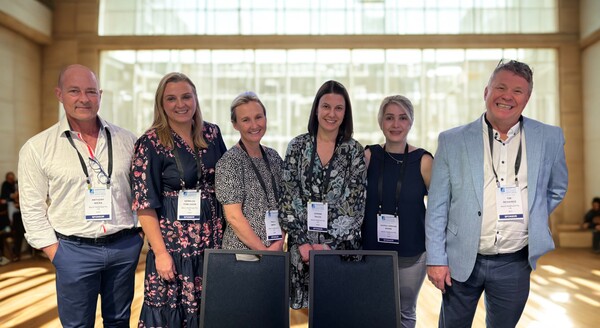Leading science and technology company Merck has welcomed new expert guidance that will harmonise the tests used in the diagnosis and treatment of endocrine disorders in children across Australia and New Zealand.

Dr Tony Huynh, the Director of Endocrinology and Diabetes at Queensland Children’s Hospital, Associate Professor in the Child Health Research Centre, and Chemical Pathologist at Mater Pathology, is the lead author of the new protocols and has long advocated for the harmonisation of testing in Australia.
“The elucidation of the underlying causes of endocrinology conditions requires the collaborative effort of clinicians and the expertise of diagnostic laboratories,” said Associate Professor Huynh.
“While endocrinologists rely on clinical acumen to diagnose endocrine conditions, they often rely on biochemical tests to confirm their clinical suspicions,” he said.
Associate Professor Huynh, who is President of the Australia and New Zealand Society for Paediatric Endocrinology and Diabetes (ANZSPED), explained that, in some cases, baseline biochemical testing does not provide a definitive diagnosis and there is a requirement to use a dynamic stimulation or suppression test. These tests require the expertise of the laboratory to ensure the samples are analysed and reported appropriately.
“We use dynamic tests to evaluate how a child’s hormonal systems may respond. This helps us determine if a child’s hormone levels are appropriate and if their glands are functioning correctly – it’s a crucial step for diagnosing and managing endocrine disorders in children,” said Associate Professor Huynh.
“Although we have made great strides in harmonising newborn screening regionally and nationally– we needed to do more to harmonise protocols for endocrinologists, biochemists and pathologists to support best practice dynamic endocrine testing in children,” he said.
The new protocols, published in a manual titled 'Australian and New Zealand Harmonised Paediatric Endocrine Dynamic Testing Manual', have been developed by the ANZSPED Laboratory and Newborn Screening Subcommittee, and endorsed by three professional societies including ANZSPED, the Australasian Association for Clinical Biochemists and Laboratory Medicine (AACB), and the Royal College of Pathologists of Australasia (RCPA).
Providing protocols for over 22 tests commonly ordered for children who have been diagnosed with endocrine disorders, the manual sets out the step-by-step process for different tests, the equipment needed, expectations on the expertise level of clinicians carrying out the test, the patients’ vitals to be observed, and any precautions or specific instructions to ensure patient safety and optimal experience throughout.
Speaking at the launch of the new protocols, Associate Professor Huynh thanked Merck for their support in producing the manual.
“We know that every time a clinician orders tests for a child, and a child and their family makes time to visit a hospital for endocrine tests, they expect a consistent testing procedure and results -and this is now a step closer, with the launch of harmonised testing protocols across Australia and New Zealand,” said Associate Professor Huynh.
Professor Craig Munns, Head, Mayne Academy of Paediatrics and Director, Child Health Research Centre at The University of Queensland, and Paediatric Endocrinologist at Queensland Children’s Hospital acknowledges the development of the harmonisation document.
“I would like to congratulate Associate Professor Huynh and the ANZSPED working group for this wonderful achievement. The harmonisation document is one of the most significant pieces of work that ANZSPED has produced. Its use by paediatric endocrinologists and pathologists will improve the management and wellbeing of children and young people with endocrine disorders across Australia and New Zealand,” said Professor Munns.
Dr Mirette Saad, Chair of the Chemical Pathology Advisory Committee for the Royal College of Pathologists of Australasia, has welcomed the finalised protocols.
“Harmonising endocrine dynamic testing protocols in paediatric care enhances diagnostic accuracy, reduces variability in clinical outcomes, and ensures equitable, evidence-based treatment for children across healthcare systems. Standardisation not only improves patient safety but also fosters more reliable data for research and long-term endocrine health strategies,” said Dr Saad.
Associate Professor Ronda Greaves, Deputy Head of Biochemical Genetics at the Murdoch Children’s Research Institute, and President-Elect for the Australasian Association for Clinical Biochemistry and Laboratory Medicine, highlighted the potential for harmonised protocols to improve clinical outcomes for children.
“This HEDT-Paeds guideline is a significant achievement as it provides standardisation of practice for paediatric centres, enabling the delivery of consistent protocols and harmonised interpretation of test results to provide equitable care for children undergoing these hormone investigations in Australasia,” said Associate Professor Greaves.
Dr Colin Yeoman, Medical Director of Merck Healthcare ANZ, welcomed the new protocols and congratulated the experts who developed the manual.
“Merck congratulates the many dedicated endocrinologists, biochemists and pathologists who contributed to the review, for driving an evidence-based best practice approach,” said Dr Yeoman.
“Providing standardised protocols that give clarity to pathologists and endocrinologists- and will ultimately benefit children living with severe hormone disorders, their families and carers,” he added.
